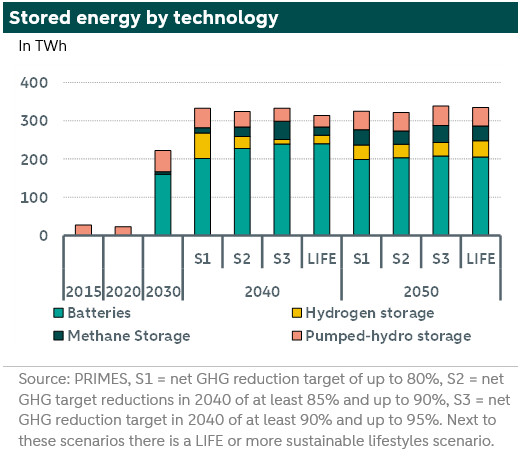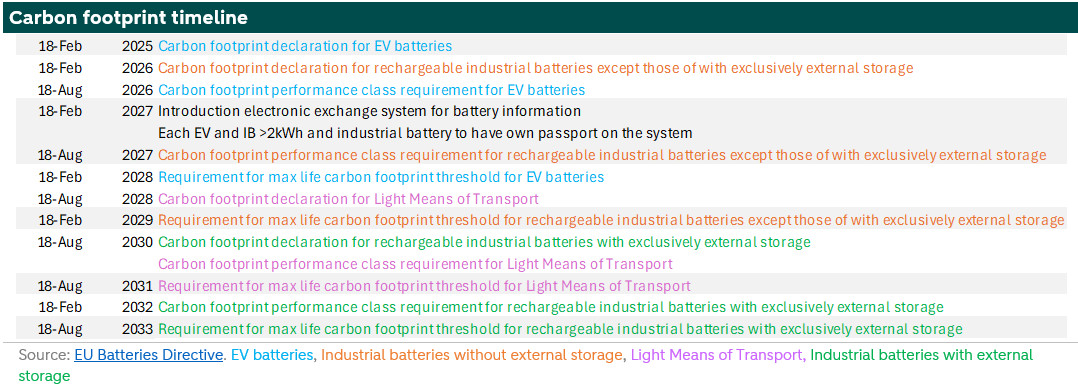ESG Economist- Batteries have a key role to play if they have low carbon footprints


Batteries play a crucial role in the energy transition by storing the energy produced by intermittent renewable sources and they help mitigating grid capacity limits. The European Commission expects batteries to surpass pumped hydro storage as the main source of providing storage between 2025 and 2030. An updated regulation for batteries entered into force on 17 August 2023. The Regulation sets rules for traceability and transparency across the battery life cycle. Furthermore, it stipulates sustainability requirements, features rules on the circularity of critical raw materials, and establishes requirements on the performance and longevity of batteries. As a result, the carbon footprint framework and recycling rates will become more stringent in the coming years affecting both consumers and producers. The Batteries Directive will have a substantial impact on the batteries on the EU market. The regulation could slow the adoption of batteries and electric vehicles in the EU.
Introduction
Energy storage plays a crucial role in the energy transition by storing the energy produced by intermittent renewable energy sources. Moreover, it helps to alleviate the grid capacity challenge. We did a deep dive on storage solutions on 25 September 2024 (see more ). Of these solutions, battery storage has an important role to play in pushing the transition forward. The European Commission has acknowledged this in its proposal of climate targets beyond 2030, where it also has published detailed scenarios for energy storage - including batteries. Currently, energy in the EU is stored mainly into pumped hydro storage. Batteries are expected to surpass pumped hydro storage as the main source of providing storage between 2025 and 2030, reaching 160 TWh by 2030. The graph below shows the stored energy by technology in the EU across different scenarios (see more page 37).
Given the importance of batteries in the energy transition, the EU has set clear regulation for batteries. In this publication we briefly revisit what battery storage is and then elaborate on the updated EU Batteries Directive and what does this mean for producers and consumers of batteries. We also give an overview of the other regulations on batteries in the Appendix. We end with a conclusion.
Battery storage
In our piece “ESG Economist: The growing importance of energy storage” (see more ) we focused on battery storage. Electrochemical energy storage technology is a technology that converts electrical energy and chemical energy into energy storage and releases it through chemical reactions. During the discharging process, the energy is converted back into electrical energy. Electrochemical energy storage systems include rechargeable batteries (see more ). There are different battery storage technologies. For example, lead-acid, lithium-ion and sodium-ion batteries are relatively well-known (see more on lithium-ion and sodium ion ), while Zinc-air (Zn-air) batteries and sodium-sulfur room temperature batteries are emerging ones. Next to stationary storage, lithium-ion batteries also play a crucial role in reducing emissions in the mobility sector.
EU Batteries Regulation
This year the Battery Directive of 2006 has been repealed by the new Batteries Regulation. The new Batteries Regulation entered into force on 17 August 2023 (see more ). It applies from February 2024 and has been requiring since August 2024 for all portable batteries sold within EU market to carry the CE (Conformité Européenne) marking. The CE marking indicates compliance with EU safety, health, and environmental protection requirements.
The Batteries Regulation lays down requirements around four main areas. First, it sets rules for traceability and transparency across the battery life cycle. Second, it stipulates sustainability requirements, notably regarding the carbon footprint of batteries. Third, it features rules on the circularity of critical raw materials, including targets for collection, recycling, material recovery and the use of recycled materials in manufacturing new batteries. Fourth, it establishes requirements on the performance and longevity of batteries (see more ). Article 7 sets out the timeline for the declaration, performance classification and the threshold on the carbon footprint (more on this below).
Regulation coverage
The Regulation applies to all categories of batteries (rechargeable and non-rechargeable) placed on the market or put into service within the EU, regardless of whether they were produced in the EU or imported. This means that lithium-ion batteries used in products (such as mobile phones), storage and electric vehicles also fall under this regulation. The Regulation separates batteries into different categories, such as batteries for electric vehicles, industrial batteries, and batteries for traction in light means of transport (LMT), such as e-bikes and e-scooters. Batteries used for traction in other transport vehicles (including rail, waterborne and aviation transport or off-road machinery) fall under the category of industrial batteries under this Regulation.
Carbon footprint and performance
An important aim of the regulation is that batteries in the EU have a low carbon footprint in their overall life cycle. The maximum life cycle carbon footprint thresholds should be future-proof. Meanwhile batteries should be durable, designed and manufactured to optimise high performance. The Batteries Regulation requires manufacturers, producers, importers and distributors to calculate and declare each battery’s carbon footprint via a Battery Passport that tracks its environmental performance throughout its lifecycle. This needs to be done for each battery model of electric vehicle batteries, rechargeable industrial batteries with a capacity greater than 2 kWh and Light Means of Transport or LMT batteries.
There are carbon footprint declarations, carbon footprint performance requirements and a carbon footprint thresholds. The carbon footprint declaration needs at least to include details about the manufacturer, battery model, geographic location of the manufacturing plant, life-cycle carbon footprint per life stage in kg CO2-eq per kWh.
Carbon footprint performance classes will be established based on the market’s distribution of carbon footprint declarations. The classes will be ranked from A (best) to subsequent classes, with Category A representing the lowest lifecycle carbon footprint. The European Commission will determine the threshold and width for each class using a three-year dataset of declarations, considering the performance of battery categories, technological advancements and other technical factors. The European Commission will establish maximum lifecycle carbon footprint thresholds for each battery category based on carbon footprint declarations, market data on battery performance classes and consideration of technical and scientific developments in the field (see more ). The Commission will review the number of performance classes and the thresholds between them every three years and, where appropriate, amend the number of performance classes and thresholds with a view to keeping them representative of the market reality and expected developments in the market (see more ). The table below shows the timeline for the carbon footprint.
Transparency and traceability
The Regulation will ensure more transparency and information about the batteries. Batteries should be labelled in order to provide end-users with transparent, reliable and clear information about batteries and waste batteries. Targets for efficiency, material recovery and recycled content will be introduced gradually form 2025 onwards. Starting in 2027, consumers will be able to remove and replace the portable batteries in their electronic products at any time of the life cycle. A digital passport will contain detailed information about each battery. The phase implementation began in July 2024 and regulates the carbon footprint, recycled content of new batteries, labelling and the introduction of an online battery information system. There are recycling targets, which differ between chemistries with specific targets for the recovery of cobalt lead, lithium and nickel. New batteries put on the market will be subject to mandatory minimum levels of recycled content requirements. The table below shows the important recycling and traceability dates of the Batteries Regulation.
Producer responsibility
The Battery Regulation also states that producers should have extended producer responsibility for the management of their batteries at the end-of-life stage. Accordingly, they should finance the costs of collecting, treat and recycle all collected batteries, carry out compositional surveys of mixed collected municipal waste, report on (waste) batteries, and provide information to end-users and waste operators about batteries and appropriate re-use and management of waste batteries. This should be done by establishing a take-back and collection network and related information campaigns that cover the whole territory of each EU Member State. In practice, this means that producers need to take batteries back from end-users for no additional charge and must ensure that the batteries are reused or recycled. However, end-users are also encouraged to take well care of their batteries.
Will the Batteries Directive harm the adoption of batteries?
International regulations consider lithium-ion batteries or products that contain lithium-ion batteries as dangerous goods (see UN 38.3 in the appendix below). The EU takes a similar approach. For this reason there is stringent regulation. The EU goes a step further in its regulation because it not only wants safe and high performance batteries for the transition but also batteries with a low carbon footprint. The carbon footprint framework is the first in its kind and therefore it will also have substantial impact on batteries being imported, produced and used in the EU. The costs for producers of batteries for the EU will likely go up as batteries have to meet stricter manufacturing and environmental standards. Some or most of these costs could end up with the end consumer. At the same time, there are good prospects that globally that the production of batteries will become cheaper because of mass production and better technologies - if material prices will do not spike up. While the regulatory burden could result in prices for batteries going down less quickly in the EU in comparison to other countries, or even increase. As a result, batteries on the EU market could stay or become more expensive than elsewhere. This could slow the adoption of batteries in the EU and even harming the energy transition.
What is more, battery electric vehicles are currently more expensive than vehicles with engines that burn fossil fuels. Incentives to buy electric vehicles have been reduced in a number of countries. As batteries costs are a crucial cost component for electric vehicles, this Batteries Directive will also affect the price of electric vehicles on the EU market. It is likely that prices will decline more slowly or stay higher. As a result the Batteries Direction could slow the wide adoption of electric vehicles on the EU market.
Conclusion
Batteries play a crucial role in the energy transition to store the energy produced by renewable sources that have the challenge of intermittency. Moreover, they help to alleviate the grid capacity challenge. The European Commission has acknowledged this and expects batteries to surpass pumped hydro storage as the main source of providing storage between 2025 and 2030. It also changed its regulation on batteries that entered into force on 17 August 2023. The Regulation sets rules for traceability and transparency across the battery life cycle. Furthermore, it stipulates sustainability requirements, features rules on the circularity of critical raw materials, and establishes requirements on the performance and longevity of batteries. The carbon footprint framework and recycling rates will become more stringent in the coming years. The EU supports the important role for batteries in the transition – but only if they have low carbon footprints. The Batteries Directive will have a substantial impact on the batteries on the EU market. The regulation could be slowing the adoption of batteries and electric vehicles in the EU.


